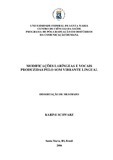| dc.creator | Schwarz, Karine | |
| dc.date.accessioned | 2007-08-22 | |
| dc.date.available | 2007-08-22 | |
| dc.date.issued | 2006-03-31 | |
| dc.identifier.citation | SCHWARZ, Karine. Vocal and laryngeal modifications produced by the vibrant lingual sound. 2006. 119 f. Dissertação (Mestrado em Fonoaudiologia) - Universidade Federal de Santa Maria, Santa Maria, 2006. | por |
| dc.identifier.uri | http://repositorio.ufsm.br/handle/1/6593 | |
| dc.description.abstract | This research had like objective to investigate the vocal and laryngeal effect and sensations that appeared from to the execution of the voiced tongue vibration technique (VTVT) applied in three series of fifteen repetitions, in the maximum time of phonation with habitual tone and intensity, with pauses of thirty seconds of passive rest between each serie. For that, had taken part in the study 24 people, of the female sex, ranging from 25 to 41 years old, without vocal complaints. All those persons were submitted to a perceptive-auditive and acoustic of voice analysis, through the Multi-Dimensional Voice Program (MDVP) - Model 5105 e Multi-
Speech - Model 3700, of Kay Elemetrics; and a valuation of the larynx, by means of video laryngostroboscopic exam, before and after the execution of VTVT. The results of the
appreciation were analyzed of quantitative and qualitative form, by means of statistic examinations, being compared with the existent bibliography about the subject. The analysis
of the results had become evident that it was statistically significant, after the execution of the VTVT: the improvement of the kind of voice; of the focus of vertical resonance; of the vocal quality; the increase of the fundamental frequency; the improvement of the parameters of the spectrographic evaluation, in the Large Band and Narrow Band filters; the maintenance of the parameters of the laryngeal images (glottal closure, constriction of the laryngeal vestibule,
amplitude and symmetry of the vibration of the vocal folds); the betterment of the medial constriction of the vestibule, according to the increase of time of the execution of the VTVT; and the predominance of the positive sensations;. The data of this study also had permitted to conclude, that the VTVT presents modifications about the glottal source and about the resonant filter | eng |
| dc.format | application/pdf | por |
| dc.language | por | por |
| dc.publisher | Universidade Federal de Santa Maria | por |
| dc.rights | Acesso Aberto | por |
| dc.subject | Fonoaudiologia | por |
| dc.subject | Voz | por |
| dc.subject | Treinamento da voz | por |
| dc.subject | Reabilitação | por |
| dc.subject | Qualidade da voz | por |
| dc.subject | Speech | eng |
| dc.subject | Language and hearing sciences | eng |
| dc.subject | Voice | eng |
| dc.subject | Voice training | eng |
| dc.subject | Rehabilitation | eng |
| dc.subject | Voice quality | eng |
| dc.title | Modificações laríngeas e vocais produzidas pelo som vibrante lingual | por |
| dc.title.alternative | Vocal and laryngeal modifications produced by the vibrant lingual sound | eng |
| dc.type | Dissertação | por |
| dc.description.resumo | Esta pesquisa teve como objetivo investigar o impacto vocal e laríngeo e as sensações surgidas frente à execução da técnica de vibração sonorizada de língua (TVSL), aplicada em
três séries de quinze repetições, em tempo máximo de fonação com tom e intensidade habituais, com intervalos de 30 segundos de repouso passivo entre cada série. Para isso,
participaram do estudo 24 sujeitos, do sexo feminino, com média de idade de 25,41 anos, sem queixas vocais. Todos indivíduos foram submetidos à análise perceptivo-auditiva e acústica da voz, por meio dos programas Multi-Dimensional Voice Programa (MDVP) - Model 5105 e Multi-Speech - Model 3700, da Kay Elemetrics e avaliação da laringe, por meio do exame de videolaringoestroboscopia, antes e após a execução da TVSL. Os resultados das avaliações foram analisados de forma quantitativa e qualitativa, por meio de testes estatísticos, sendo comparados com a bibliografia existente sobre o assunto. A análise dos resultados evidenciou que foi estatisticamente significativo, após a execução da TVSL: a melhora do tipo de voz; do foco de ressonância vertical; da qualidade vocal; o aumento da freqüência fundamental; a
melhora de parâmetros da avaliação espectrográfica, em filtros de Banda Larga e Banda Estreita; a manutenção dos parâmetros das imagens laríngeas (fechamento glótico, constrição do vestíbulo laríngeo, amplitude e simetria de vibração das pregas vocais); a melhora da constrição medial do vestíbulo, conforme o aumento do tempo de execução da TVSL; e o predomínio de sensações positivas. Os dados desta pesquisa permitem concluir, que a TVSL apresenta modificações sobre a fonte glótica e sobre o filtro ressonantal | por |
| dc.contributor.advisor1 | Cielo, Carla Aparecida | |
| dc.contributor.advisor1Lattes | http://lattes.cnpq.br/8424979142095675 | por |
| dc.contributor.referee1 | Mezzomo, Carolina Lisbôa | |
| dc.contributor.referee1Lattes | http://lattes.cnpq.br/3084638267716841 | por |
| dc.creator.Lattes | http://lattes.cnpq.br/5016577403420507 | por |
| dc.publisher.country | BR | por |
| dc.publisher.department | Fonoaudiologia | por |
| dc.publisher.initials | UFSM | por |
| dc.publisher.program | Programa de Pós-Graduação em Distúrbios da Comunicação Humana | por |
| dc.subject.cnpq | CNPQ::CIENCIAS DA SAUDE::FONOAUDIOLOGIA | por |


